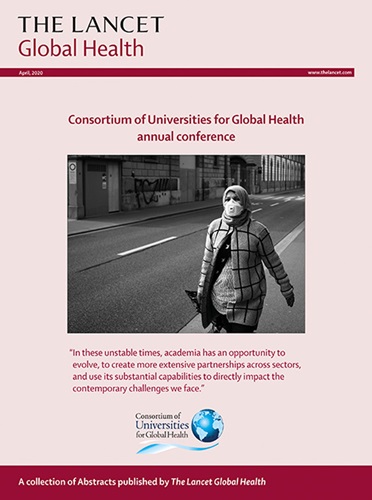在开始接受抗逆转录病毒疗法前筛查艾滋病毒感染者结核病的血液 RNA 生物标志物:诊断准确性研究
IF 19.9
1区 医学
Q1 PUBLIC, ENVIRONMENTAL & OCCUPATIONAL HEALTH
引用次数: 0
摘要
未确诊的结核病仍然是艾滋病毒感染者面临的一大威胁。多种血液转录组生物标志物已显示出诊断结核病的前景。我们试图评估它们在系统性抗逆转录病毒疗法(ART)前结核病筛查中的诊断准确性和临床实用性。我们在南非开普敦的一家社区医疗中心连续招募了转诊开始接受抗逆转录病毒疗法的成年人(年龄≥18 岁),无论其是否有症状。我们采集了痰液(必要时采用诱导法),进行了两次液体培养。全血 RNA 样本使用定制的 Nanostring 基因面板进行转录分析。我们使用接收者工作特征曲线下面积(AUROC)分析以及预设阈值(比健康对照组平均值高两个标准分;Z2)下的灵敏度和特异性,测量了七个候选 RNA 标志(一个单基因生物标志物 [BATF2] 和六个多基因生物标志物)对培养状态参考标准的诊断准确性。临床实用性通过计算决策曲线分析中的净获益进行评估。我们比较了 C 反应蛋白(CRP;阈值≥5 mg/L)、世界卫生组织四症状筛查(W4SS)和世界卫生组织结核病分诊测试目标产品描述的性能。共纳入了 707 名艾滋病毒感染者(其中女性 407 人[58%],男性 300 人[42%]),CD4 细胞计数中位数为 306 个/毫米(IQR 184-486)。在 676 名有痰培养结果的参与者中,89 人(13%)经培养证实患有结核病。七种 RNA 特征具有中度到高度相关性(斯皮尔曼秩系数 0-42-0-93),对结核菌培养阳性的判别具有相似的 AUROC(0-73-0-80),但在统计学上都不优于 CRP(AUROC 0-78,95% CI 0-72-0-83)。各 CD4 细胞数层的诊断准确性相似,但 W4SS 阴性参与者的诊断准确性(AUROCs 0-56-0-65)低于 W4SS 阳性参与者(AUROCs 0-75-0-84)。AUROC点估计值最高的 RNA 生物标志物是四基因特征(Suliman4;AUROC 0-80,95% CI 0-75-0-86),在 Z2 临界值时灵敏度为 83%(95% CI 74-90),特异性为 59%(55-63)。在决策曲线分析中,Suliman4 和 CRP 在指导肺结核确诊检测方面具有相似的临床效用,但两者的净效益均高于 W4SS。在探索性分析中,结合 CRP(≥5 mg/L)和 Suliman4(≥Z2)的方法的灵敏度为 80%(70-87),特异性为 70%(66-74),净效益高于单独使用其中一种生物标记物的方法。与基于症状的筛查相比,RNA 生物标志物在指导艾滋病病毒感染者开始抗逆转录病毒疗法前的结核病确诊检测方面显示出更好的临床实用性,但其性能并未超过 CRP,也未达到世界卫生组织推荐的目标。可能需要采用不依赖干扰素的方法来提高宿主反应生物标志物的准确性,以支持抗逆转录病毒疗法启动前的结核病筛查。南非医学研究理事会、欧洲与发展中国家临床试验合作组织 2、美国国立卫生研究院国家过敏与传染病研究所、惠康信托基金会、国家健康与护理研究所、伦敦皇家内科医学院。本文章由计算机程序翻译,如有差异,请以英文原文为准。
Blood RNA biomarkers for tuberculosis screening in people living with HIV before antiretroviral therapy initiation: a diagnostic accuracy study
Undiagnosed tuberculosis remains a major threat for people living with HIV. Multiple blood transcriptomic biomarkers have shown promise for tuberculosis diagnosis. We sought to evaluate their diagnostic accuracy and clinical utility for systematic pre-antiretroviral therapy (ART) tuberculosis screening. We enrolled consecutive adults (age ≥18 years) referred to start ART at a community health centre in Cape Town, South Africa, irrespective of symptoms. Sputa were obtained (using induction if required) for two liquid cultures. Whole-blood RNA samples underwent transcriptional profiling using a custom Nanostring gene panel. We measured the diagnostic accuracy of seven candidate RNA signatures (one single gene biomarker [BATF2] and six multigene biomarkers) for the reference standard of culture status, using area under the receiver-operating characteristic curve (AUROC) analysis, and sensitivity and specificity at prespecified thresholds (two standard scores above the mean of healthy controls; Z2). Clinical utility was assessed by calculating net benefit in decision curve analysis. We compared performance with C-reactive protein (CRP; threshold ≥5 mg/L), WHO four-symptom screen (W4SS), and the WHO target product profile for tuberculosis triage tests. A total of 707 people living with HIV (407 [58%] female and 300 [42%] male) were included, with median CD4 count 306 cells per mm (IQR 184–486). Of 676 participants with available sputum culture results, 89 (13%) had culture-confirmed tuberculosis. The seven RNA signatures were moderately to highly correlated (Spearman rank coefficients 0·42–0·93) and discriminated tuberculosis culture positivity with similar AUROCs (0·73–0·80), but none statistically better than CRP (AUROC 0·78, 95% CI 0·72–0·83). Diagnostic accuracy was similar across CD4 count strata, but lower among participants with negative W4SS (AUROCs 0·56–0·65) compared with positive (AUROCs 0·75–0·84). The RNA biomarker with the highest AUROC point estimate was a four-gene signature (Suliman4; AUROC 0·80, 95% CI 0·75–0·86), with sensitivity 83% (95% CI 74–90) and specificity 59% (55–63) at the Z2 threshold. In decision curve analysis, Suliman4 and CRP had similar clinical utility to guide confirmatory tuberculosis testing, but both had higher net benefit than W4SS. In exploratory analyses, an approach combining CRP (≥5 mg/L) and Suliman4 (≥Z2) had sensitivity of 80% (70–87), specificity of 70% (66–74), and higher net benefit than either biomarker alone. RNA biomarkers showed better clinical utility to guide confirmatory tuberculosis testing for people living with HIV before ART initiation than symptom-based screening, but their performance did not exceed that of CRP and fell short of WHO recommended targets. Interferon-independent approaches might be required to improve accuracy of host-response biomarkers to support tuberculosis screening before ART initiation. South African Medical Research Council, European and Developing Countries Clinical Trials Partnership 2, National Institutes of Health National Institute of Allergy and Infectious Diseases, The Wellcome Trust, National Institute for Health and Care Research, Royal College of Physicians London.
求助全文
通过发布文献求助,成功后即可免费获取论文全文。
去求助
来源期刊

Lancet Global Health
PUBLIC, ENVIRONMENTAL & OCCUPATIONAL HEALTH-
CiteScore
44.10
自引率
1.20%
发文量
763
审稿时长
10 weeks
期刊介绍:
The Lancet Global Health is an online publication that releases monthly open access (subscription-free) issues.Each issue includes original research, commentary, and correspondence.In addition to this, the publication also provides regular blog posts.
The main focus of The Lancet Global Health is on disadvantaged populations, which can include both entire economic regions and marginalized groups within prosperous nations.The publication prefers to cover topics related to reproductive, maternal, neonatal, child, and adolescent health; infectious diseases (including neglected tropical diseases); non-communicable diseases; mental health; the global health workforce; health systems; surgery; and health policy.
 求助内容:
求助内容: 应助结果提醒方式:
应助结果提醒方式:


